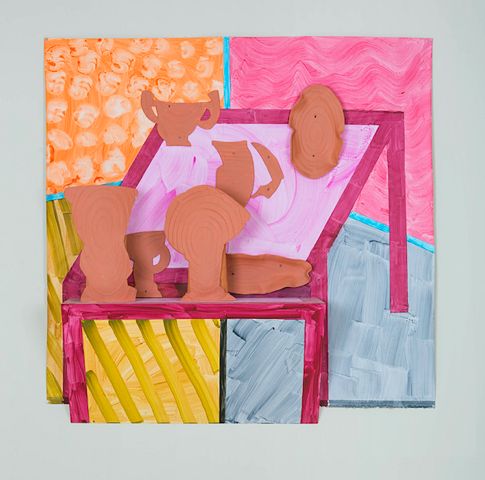There are certain mornings when kitchens become works of art. The red checkered tablecloth, the fruits in the fruit bowl, the colored coffee mugs with their scratched off insignias, and the cabinet's best selection of boxed cereals, frozen momentarily in arbitrary formations, all illuminated by morning light.
Mornings like these must occur quite often in the home of Betty Woodman, an 86-year-old artist who has both heeded and challenged the tradition of ceramics for 60 years. "If you go in our kitchen, we’re very aestheticized," Woodman explained in an interview with The Huffington Post Arts. "What we eat out of, what cup we choose to drink out of in the morning, it’s an important decision. It brings us joy, pleasure."
"We both like to live with art around us and to look at it," speaking also for her husband of 63 years, George, a photographer. For the Woodmans, this means lots of photographs and lots of ceramics. Colorful vessels hovering between function and fine art, kitchen shelfs appearing like museum walls.

Woodman, born in 1930 in Connecticut, first encountered clay in a high school art class when she was 16. "It was sort of like magic," she recalled. "We were given some clay and using our hands we could just make it into a shape. The first thing I ever made was a pitcher. As far as I was concerned that was what I wanted to do. It fell into my hands."
Before long Woodman dove deep into the history of clay, studying prehistoric Chinese pots, Bauhaus designs, customary tea sets and Etruscan vessels with matched intensity. But when it came to her own work, Woodman considered herself a craftsman more than an artist, at least at first. "I was interested in ceramics not as a fine art," she said. "I wanted to make functional things for people to use. I don’t think the question entered my mind."
Slowly, gradually, Woodman wanted more. She wanted her work to be seen and understood in a larger context. She paired with Max Protetch, a gallerist known for showing architectural drawings, who was conveniently familiar with objects like hers, that slip in and out of the boundaries of fine art. He became the first person to exhibit Woodman's work.

As a result of Woodman's pioneering spirit, today's artists have embraced ceramics as a viable, mainstream artistic technique. But at the beginning of Woodman's career, potters and ceramicists were regarded in a category of their own, looming between artist and artisan. "It was just something different," Woodman said. "Maybe admired -- but not seen on the same page. Today there is an understanding of clay as a material to make art with, and that was not always true."
While Woodman was making work on the East Coast, Californian Peter Voulkos was sparking a ceramics resurgence in California, a movement dominated by men. "It was macho," Woodman explained. "It was a man’s world. Being a woman was not easy to achieve some kind of recognition." Woodman recalled the prevalence of male professors in her university's ceramics department, solidifying a male-to-female artist ratio that followed the graduating class into the outside world.
Woodman hypothesizes that with the rise of second wave feminism in the 1960s, curators began to feel self-conscious about curating all male shows, and rightfully so. Woodman was soon invited to participate in male-heavy group exhibitions, and eventually earned her own solo shows. However, as Woodman explained, her interest in clay was far more isolating in terms of art world acceptance than her status as a woman.

Now in her eighties, Woodman has become one of the most influential figures in ceramic arts, with a Metropolitan of Art solo show under her belt and simultaneous current exhibitions at New York's Salon 94 and London's Institute of Contemporary Arts (ICA). "I would say that my work has quite a lot of visibility at the moment," she said, still hoping that her work will reach and inspire the next generation of ceramicists. "I want younger artists to be able to see what I do. More than to hear what I’m saying, they should look at my work."
Woodman's ICA show, her first in the U.K., titled "Theatre of the Domestic," features work from the past decade -- rowdy vessels, flattened mosaics and other thingamajigs that don't easily fall into any one category. Three-dimensional jugs mingle with two-dimensional simulacrums, streaks of unruly color indiscriminately scattered on both.
The exhibition offers up a dreamy domestic space, removed of functional obligations, free to morph into something ever so slightly more theatrical. "I think that I was looking carefully and with a great pleasure at a lot of [Pierre] Bonnard paintings," Woodman said. The French post-Impressionist painter is known for his disorienting depictions of interior spaces, often involving a table adorned with a basket of fruit or a pot of tea, a window and a cat.
Woodman's show dissects Bonnard's breakfast nooks like the most playful of surgeons, serving up a deconstructed living space in which tables emerge from canvases, vases are sliced down the middle, and paintings rest on the floor. Perhaps most delightful are the "Wallpaper Pieces," made from the leftover slabs of clay from other works. Woodman glazed the scraps and arranged them in a vibrant wall mosaic, the excess parts converging on the wall like old friends.
"It’s really very nice the way the show links back to my original interest in pottery and the domestic object," Woodman said. Not surprisingly, home base and domestic space continue to play a large role in the artist's creative process, which takes place primarily in her studio, based in her Chelsea home. If you leave your kitchen suspecting the various shapes and colors on display might spring into action in your absence, this show will make sense.

"I always had my studio at home," Woodman said. "It made it easier for me to have children and be able to do my work." Woodman's son is electronic artist Charles Woodman and her daughter was the late photographer Francesca Woodman. "We had breakfast, the kids went to school, I went into my studio. Ceramics is time-based work. When a piece the right thickness you put the handle on, turn on the kiln, walk out of the studio, put the stew in the oven, give it a stir. It’s a personal taste, but it's how I like to work."
The arrangement also allowed for a spongy relationship between Woodman and her husband's practices, which have flourished alongside each other for the past six decades years. "We laugh because our work is really different but I think we influence each other. We've lived together all this time, we don’t ignore what each other is doing."
You've probably heard the ice breaker: if you could invite anyone, living or dead, to a dinner party, who would you choose? Woodman's two exhibitions loosen the reigns on the question, allowing inanimate objects to join the gathering. Who is invited to Woodman's domestic theater? Pompeii's wall frescoes, Fra Angelico's paints, Matisse's visual sense of humor, maybe the dependable joy of my favorite coffee cup.
Like a good host eager to provide her guests a brief and delightful respite from the trials of everyday life, Woodman hopes her viewers feel a bit lighter in the presence of her ceramic goods. "I hope they experience some kind of beauty, the experience of something which is pleasant," Woodman says. Of course, she's a host to her objects as well. "And as for the vases I've been making, I want to give them a place to live."
Betty Woodman's "Breakfast At The Seashore Lunch In Antella" is on view until February 21, 2016 at Salon 94 in New York. "Theatre of the Domestic" is on view at London's ICA until April 10, 2016.









Also on HuffPost:

